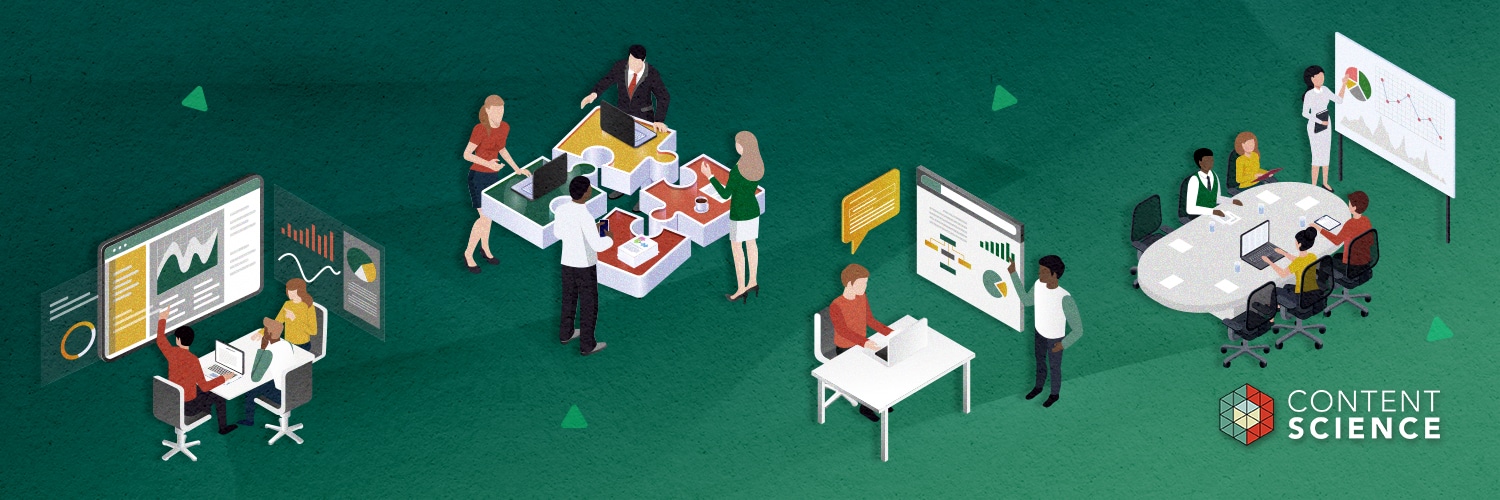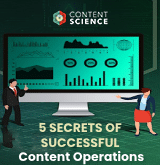
Often, content strategy happens in starts and stops. Teams struggle to formulate a strategy. And, once they have a strategy in place, they may find that it isn’t working. Perhaps they aren’t reaching consumers, or content is getting stuck in the idea phase, or maybe the content management system just can’t support what the team had envisioned.
This article will help you over these hurdles. We walk you through 5 strategic questions for optimizing your content strategy and ensuring you create winning content. You can find more about these questions in The Content Advantage by Content Science President Colleen Jones.
1. What Is Our Winning Aspiration?
This answer should factor in your content vision and your business goals.
Determine the purpose and vision: Your winning aspiration should take into account the product or initiative requiring content or the content product. Take Marriott, for example. When the company launched its content studio, it stated that it wanted to be the Red Bull of the hotel industry. Marriott’s goal was to be a leader in lifestyle content; the way Red Bull is with alternative sports content. Your goal and vision might be different, but the point is to define it clearly.
2. Where Will We Play?
This question drives you to consider the right playing field—the place to compete where you have the best chance to win.
Consider all playing fields: As our world becomes increasingly digital, and our relationships with customers grow longer, we face many potential places to make a content play. We can play in myriad channels, touchpoints, and formats, such as our website, in mobile applications, on social media sites, in print, on kiosks and digital signage, in voice applications such as Alexa, in games and virtual reality, and many more. We also have the opportunity to play in many stages or phases of the customer relationship.
But be selective: While it might be tempting to compete on all of these “fields,” the reality is that you will have to be selective. Performing a content analysis will go a long way toward helping you determine exactly where you should be playing.
3. How Will We Win?
Answering this question should consider and potentially synthesize your value proposition, your competitive advantage, and your unique content approach.
Consider this: “What gives us the unique right to win?”: Take FitBit for example. FitBit has a special relationship with its customers that is mediated by unique touchpoints, such as its watch and mobile application. FitBit can take advantage of what we call “coachable moments”—where a customer has succeeded, failed, or hit a significant milestone toward a health goal—with content. And FitBit does. FitBit provides immediate messages to address the moment and guides customers to more in-depth advice and guidance. As you consider your unique right to win on content, review your analysis and look for indicators of your unique
- Expertise
- Brand values, characteristics, or personality
- Existing content assets
- Relationship and touchpoints with customers
- Gaps in competitive content offerings
Keep all types of competitors in mind: Remember that in content your competitors are not only your business competitors but also potential sources of pertinent content. To continue the FitBit example, FitBit competes not only with other fitness watches but also with other sources of fitness, wellness, and performance content, such as Under Armour’s myFitnessPal.
4. What Capabilities Must Be in Place?
You cannot build a content strategy without having the related content capabilities.
Assess your content operations maturity level: Content operations maturity is a way to articulate the degree to which your organization can make content strategies and plans happen. We have found that the more mature content operations are, the more likely they are to report success. You can do a pulse check of your content operations maturity level by answering this brief assessment.
Decide what you will do about gaps in capabilities: If you have gaps in your capabilities, the question becomes, “Are we willing to close these gaps so we can execute our strategy? Or do we need to adjust our strategy to account for these gaps?” For instance, companies ranging from Red Bull to TD Ameritrade have created in-house studios that give them the ability to offer rich editorial and educational content. If your company is not willing to make that kind of commitment, then you need to closely consider how you will adjust and adapt existing capabilities to achieve your strategy.
5. What Management or Operational Systems Are Required?
Consider what content management technology, management processes, and measures you have or will need to sustain your content strategy.
Make sure you have the right processes in place: To consistently win with your content, you need strong systems and guidelines in place to consistently produce, publish, promote, and measure content.
Check that your technology and strategy align: Even if you have the right systems and content in place, you have to make sure they are in sync. For example, we worked with a telecommunications and entertainment conglomerate on a personalization-driven content strategy, such as providing highly relevant offers and content suggestions. In the course of fleshing out the strategy, we discovered that even though the company possessed a wealth of customer data and a new, robust content management system, their systems lacked integration and alignment. At the same time, their content was not structured in their content management system at the right level of granularity. The content was mostly composed of pages and documents, not of components (or chunks) that could be extracted and reused. The telecommunications and entertainment company realized they had to fix these systems before they could embrace the content strategy they desired.
Moving Forward
Now that you have an understanding of the 5 essential questions to help you optimize your content strategy, you’re ready to take the next steps. Here are some suggestions for how to go from idea to full implementation with help from Content Science:
Dig in deeper with a certification course: This article features content from Content Science’s Content Strategy + Analysis Certification program, which is part of our Content Science Academy. The certification course provides an introduction to content strategy and covers topics that will help you create a winning content strategy—and provides examples, practice assignments, and tools to get you going.
Get guidance from The Content Advantage: There are even more content strategy insights and examples in The Content Advantage. You can use the information in the book to help you put together a content strategy that works for your organization.
Partner with Content Science: We are here to help you. If your organization is ready to get to work on a content strategy, you can engage Content Science to work with you and your team to develop a strategy that will put you on the path to success.
This article is part of our ongoing How To series, in which we help you learn how to get started in or improve across key content areas. Catch up with more in this series:
Events, Resources, + More
5 Secrets of Content Ops Success: Webinar
Learn how the most successful organizations scale and mature content operations. Based on our research with 700+ content leaders and professionals.
The Ultimate Guide to End-to-End Content
Discover why + how an end-to-end approach is critical in the age of AI with this comprehensive white paper.
The Content Advantage Book
Learn more about the much-anticipated third edition of the highly rated book by Colleen Jones. Preorder the electronic version.
20 Signs of a Content Problem in a High-Stakes Initiative
Use this white paper to diagnose the problem so you can achieve the right solution faster.
Workshop: Are You Ready for AI?
Is your organization really ready for AI at scale? Let the Content Science team guide your leaders through assessing 4 areas of readiness.
Upskill with Content Science Academy
Training for modern content roles through on-demand certifications + courses or live workshops.








Comments
We invite you to share your perspective in a constructive way. To comment, please sign in or register. Our moderating team will review all comments and may edit them for clarity. Our team also may delete comments that are off-topic or disrespectful. All postings become the property of
Content Science Review.